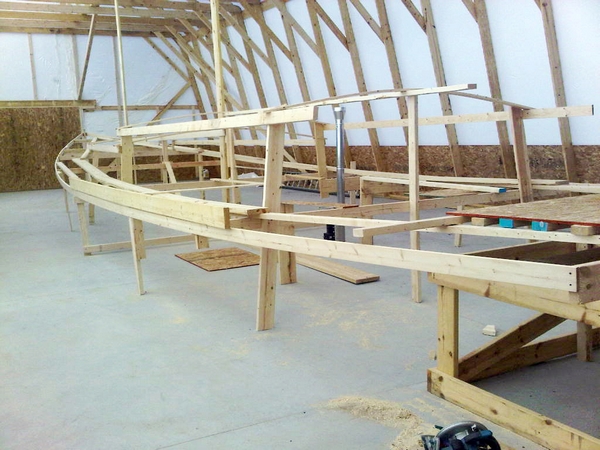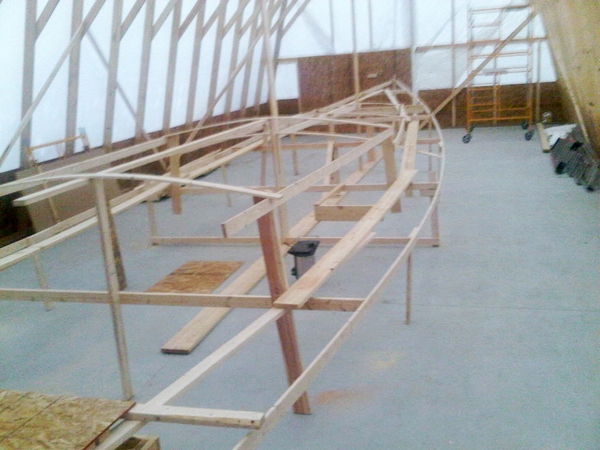
by Captain Hugh Covert
The need for a bigger boat with more room, fused with a desire to sail a tall ship with passengers, resulted in a plan for a new boat which will be called the HURON JEWEL. The current boat I have is in good shape, sails well, and has been a lot of fun for 17 years. It had grown in the planning stage from 18 to 20, 22, and finally to 36 feet long on deck. But, while it grew much longer and somewhat wider, it didn’t gain much in headroom. I have been captain of several big sailing vessels around the U.S. and the Bahamas, and have built several boats, so the idea of building one to sail close to home seemed natural.
Various limitations of water depth and haul-out facilities produced a plan for a boat 60 feet on deck, 14 feet wide, schooner-rigged with two masts, a centerboard, and shallow draft. The inspiration for the design is an early 19th-century Baltimore Clipper-type Virginia pilot schooner whose measurements were taken by a French naval engineer in 1820. The lines were later re-published by Howard Chapelle, the American naval architect, and historian. Reuel Parker, a leading light of the wooden boat fraternity, adapted the plans to modern building techniques and built a successful boat 20 years ago that cruises the East Coast and Bahamas, proving the validity of the concept. My boat will be named Huron Jewel and be licensed to carry six passengers on day sails in Potagannissing Bay and voyages to the North Channel.
In working out my ideas about a new boat, I drew heavily upon Mr. Parker’s experiences and developed a plan further adapted to current wood/epoxy construction and U.S. Coast Guard rules.
We have built a 32′ x 72′ boat shop and are now lofting: drawing lines on the concrete floor based on a full-size model temporarily pinned together to get the dimensions just right. We’ve already acquired two Yanmar diesel engines for power and a tiny wood stove made in Benton Harbor, Michigan for heat and the proper aroma of wood smoke that belongs on a traditional schooner. We are sourcing as much material as possible through suppliers and manufacturers in Michigan, and have pledges of volunteer help from the local community.
The sail plan is that of a typical 19th-century schooner, gaff rig with four lower sails: jib, staysail, a boomed foresail, and mainsail. A main topsail will be part of the working canvas, making for about 1,700 square feet, with an additional fisherman staysail for lighter winds.

The hull will be planked in Douglas fir (milled in Michigan) and sheathed in WEST SYSTEM Epoxy (made in Bay City, Michigan) and fiberglass cloth. The interior will have eastern white cedar, as well as birch and other hardwoods. The masts will be of wood as well. We’ll be carrying almost 14,000 pounds of ballast, mostly lead, but also counting the weight of engines and gear such as anchor chain.
We plan to launch in Big Shoal Bay in the summer of 2017, after building the hull and turning it over in the summer of 2016 to finish the interior.
She will be a very fast and stable boat, suited to cruising around the rocky shores of Drummond Island, the Les Cheneaux Islands and the North Channel, and capable of extended voyages to the Caribbean.
Captain Hugh Covert owns and manages Shelter Island Transit Company on Michigan’s Drummond Island. We’ll be keeping in touch with him as the project progresses, and hope to provide updates in future issues of Epoxyworks.





